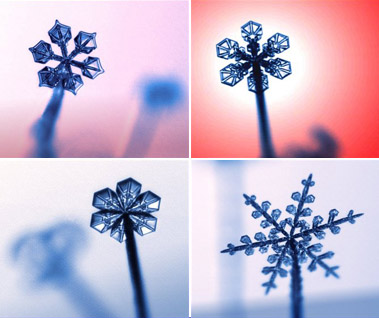 |
|
|||
Click here to view all Upcoming Events// IFF Directors Talks
IFF Directors Talks 2012 // Previous IFF Lectures THE MOSELY SNOWFLAKE SPONGE THE ART OF ITERATION MAKING SPACE IFF Director Margaret Wertheim speaks at Art Center College of Design Captain Charles Moore Talks About Plastic Trash IFF Director Margaret Wertheim Seeing Anew [IFF-L20] Structural Considerations of the Business Card
Sponge[IFF-L17] Where the Wild Things Are 2: Things That Think: Where the Wild Things Are: Crocheting the Hyperbolic Plane: Darwinism on a Desktop: The Logic Alphabet Why Things Don't Fall Down Kindergarten: Crocheting the Hyperbolic Plane [IFF-L5] The Mathematics of Paper Folding [IFF-L4] The Physics of Snowflakes [IFF-L3] Crocheting the Hyperbolic Plane [IFF-L2] The Figure That Stands Behind Figures: // Previous Events Crochet Hyperbolic Workshop |
The Physics
of Snowflakes [IFF-L3] Thursday, June 24, 2004 @ 7:30pm |
|||
 |
||||
| Synthetic snow crystals grown in a
laboratory Images courtesy Kenneth G. Libbrecht |
||||
| Kenneth Libbrecht is chairman of the physics department at the California Institute of Technology. He works on the LIGO gravity detector, whose purpose is to capture gravitational waves from astrophysical events such as supernovae and black holes. In his spare time, Dr. Libbrecht builds specialized chambers for studying the formation of snow crystals, a phenomenon still poorly understood. He is the author of The Snowflake: Winter’s Secret Beauty. In this lecture, Dr Libbrecht will talk about the physics of snow crystals and explain his recent discovery of the mechanism behind ice spikes. Meteorological definitions distinguish a single “snow-crystal” from the more general term “snowflake,” which may also apply to clusters. In the 1930’s, the Japanese physicist Ukichiro Nakaya set out to study ice formation in the laboratory, attempting to grow crystals suspended on a thread. Individual specimens proved elusive however, for the threads became encrusted with frost. Nakaya tried strings of cotton and silk, he experimented with wires and spider’s web. Eventually he found the solution in a strand of rabbit’s fur, where natural oils discouraged the nucleation of frost and allowed the development of isolated flakes. The result of this research was his famous snowflake morphology diagram. Following in Nakaya’s footsteps, Ken Libbrecht is trying to understand the mechanics of snow crystal formation at varying degrees of temperature and humidity. In his CalTech lab, Nakaya’s rabbit hair has been replaced by a purpose designed, pressure-cooker-sized chamber, in which, using a 2000 volt electric current, Libbrecht grows needles of ice. His crystals sprout like blossoms from the ends of these stalks - miniature florets of ice mere millimeters across. Libbrecht’s research focuses on crystallization at the boundary of the quasi-liquid layer which surrounds all ice structures, and has led to his theory of “structure dependent attachment kinetics.” |
||||
| Go to Dr Libbrecht's snow crystal site
|
||||
| © 2003–2018 The Institute For Figuring | ||||